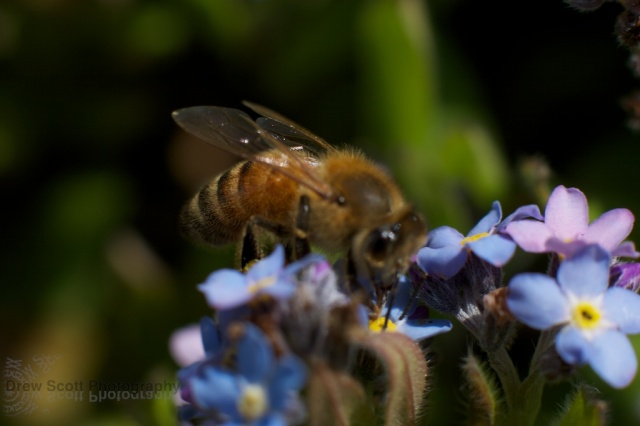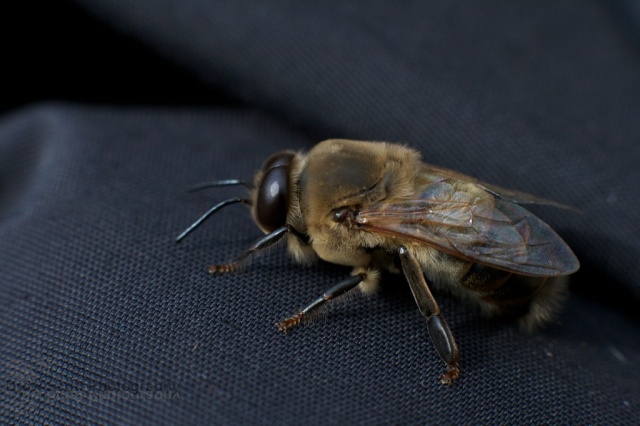Another revision post for my BBKA Module 6 Honeybee Behaviour exam on Saturday.
Section 6.5: the social organisation of the honeybee colony including worker policing
Honeybee colonies rely on large numbers of more or less sterile individuals working together to raise young and look after the colony’s needs on behalf of a few reproductives, the queen and the drones. The colony system is based on individuals belonging to one of three castes, with labour divided up accordingly…
The Queen:
The star of the show, the colony’s egg laying machine. The diploid (two sets of chromosomes) queen lays day and night during the spring and summer, with only short breaks to feed and rest.
The queen has certain weapons to keep the egg laying to herself. 9-ODA (9-oxodec-2-enoic acid) is the main component of her ‘queen substance’ pheromone mix which inhibits the workers building queen cells and worker ovary development. The system usually works well, with a queen-right colony having on average only 0.1% of the workers producing adult males and only 0.01% of the workers having full-sized eggs in their ovaries.
Should the colony lose its queen, the absence of queen substance and a lack of pheromone given off by growing brood will cause the workers to raise a final set of drone sons. Eggs laid by workers can be spotted because their abdomens are too short to reach the bottom of the cell, so the eggs will be stuck to the side. More than one egg may be laid in a cell and they are laid in a haphazard, spotty manner rather than the methodical, neat laying pattern of the queen’s rows of eggs. In a queen-right colony workers will police the eggs, removing and eating eggs laid by their worker sisters because they will not smell of the queen’s pheromones.
A queen’s pheromones also stimulate comb construction and foraging in general, particularly for pollen. The minimum number of worker bees required to be together before comb building begins is lowest (50 bees) in the presence of a laying queen and progressively increases in the presence of a virgin queen (75 bees) and a dead queen (200-300). Queenless bees build no new comb no matter how big the colony is.

A honeybee queen and her court. The workers take it in turns to feed, lick and groom the queen, picking up some of her pheromones as they do so. They will then go on to touch other worker bees, helping to distribute queen substance around the colony.
The Worker:
Also diploid, workers live for about 40 days in the summer, taking on jobs in a sequence moving gradually out from the brood nest into the outside world. Winter worker bees can live for several months as they spend most of their time clustering in the hive, conserving their energy so they can survive to spring.
The Drone:
The laziest colony members, drones are male and haploid, possessing only one set of chromosomes from an unfertilised egg. They have no father, only a grandfather. Although drones make little contribution to everyday colony life, their only purpose being to mate with a young queen, some beekeepers feel the workers like having drones around and handle differently if drones are removed. There is also some evidence that their large bodies can help keep brood warm in cold weather.
To help them fulfil their role as mating machines, drones are big with strong abdominal and flight muscles. They have larger antennae carrying ten times as many sense organs as those of a worker, helping them detect the wafting pheromone of a young queen up in the sky. Having found a queen by scent, the drone’s enormous eyes come into play, helping him keep her in sight as he flies up behind her for mating.
Drones will often pay visits to neighbouring hives, perhaps in the hope that they may find a virgin queen to get a head start on the chase once she leaves.
A handsome drone in prime mating condition, his chunky thorax almost looking like a lion’s mane. Was he successful? We’ll never know.
More revision/Module 6 themed posts:
- 1st Honey bee behaviour revision post: bee jobs
- 2nd Honey bee behaviour revision post: honey bee mating
- 3rd Honey bee behaviour revision post: the queen’s egg laying behaviour and seasonal variations in the size of a colony
- 5th Honey bee behaviour revision post: bee communication
- 6th Honey bee behaviour revision post: bee foraging
- Passed 🙂
- BBKA exam feedback




Pingback: BBKA module 6 honeybee behaviour: 6.5 Social organisation of a honeybee colony | Miss Apis Mellifera
Great photos, especially the queen ones.
I just read that the queen can lay DIPLOID males…not sure why, because they get eaten in the larva stage by the workers.
I love to read about the social organization of honey bees. It’s so fascinating. Thanks for posting.
LikeLike
Interesting, I hadn’t heard before that the queen can lay diploid males. I did a bit of googling after reading your comment and it seems it’s linked with inbreeding. They must smell different for the workers to be able to identify them.
LikeLike
I thankyou for all your hardwork. I learn from it. Are there anymore moduls available ?
LikeLike
Thanks Jacobus. I have also taken Module 1 on Honeybee management – https://adventuresinbeeland.com/tag/module-1/ and Module 3 on Diseases – https://adventuresinbeeland.com/tag/module-3/.
You may also be interested in the excellent module notes put together by one of the English beekeeping associations, Mid Bucks. If you visit this link – http://blog.mbbka.org.uk – and scroll down to the ‘Categories’ section, you will see links for Module 1, Module 2 etc. The notes are provided as free pdfs which you can save and print.
LikeLike